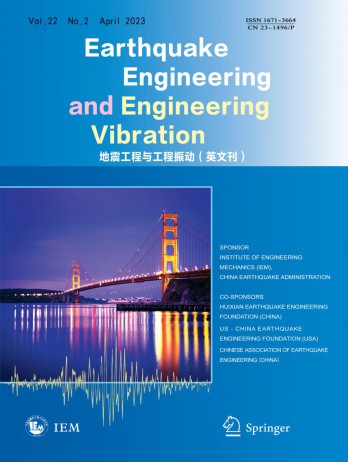
Earthquake Engineering and Engineering Vibration雜志簡介
《Earthquake Engineering and Engineering Vibration》由中國地震局工程力學研究所主辦、美國多學科地震工程研究所中心(MCEER)協辦。
《Earthquake Engineering and Engineering Vibration》是反映我國地震工程與工程振動領域最新成果和國外該領域最新進展的學術性期刊,旨在促進國際學術交流,推動地震工程與工程振動學科的發展,減輕地震災害。
《Earthquake Engineering and Engineering Vibration》主要刊登以下內容的綜合評述、專題研究論文和科研簡報:結構和工程體系震害評定,強震觀測與分析,土木基礎設施的地震危害性與危險性分析,場地對結構的影響和巖土工程,建筑物與生命線系統的抗震性能和設計原理,結構控制,現有基礎設施系統的修復策略,結構動力學以及和地震工程相關的阻尼理論的進展,應急傳感與監測系統和高性能材料在地震工程中的應用,以及風、波良和其它動荷載下土木工程結構振動問題。
Earthquake Engineering and Engineering Vibration發文方向
強震觀測與分析、結構和工程體系震害評定、土木基礎設施的地震危害性和危險性分析、場地效應和巖土地震工程
Earthquake Engineering and Engineering Vibration雜志特色
Title Page:
The title page should contain: Title, Authors, Affiliations,
Acknowledgement, and Footnotes supplying: Correspondent
author‘s information including: the full name, complete mailing address, telephone and fax number, and, if available, e-mail address; Job titles of all authors; and The name(s) of sponsor(s) of the research contained in the paper, along with grant number(s), if any.
General: The manuscript should be provided in single-spaced typing Time New Roman, 10.5 pt., on A4 size pages in electronic format using Microsoft Word. It must be written in English and should not exceed 13,000 word-equivalents. (A journal page contains approximately 1,300 words.) Technical notes should not exceed 4,000 word-equivalents. If it is necessary to include additional information, such as appendices, these should be submitted electronically for inclusion on a web site for the journal.
Abstracts: Each paper should include an Abstract of 150-200 words, reporting concisely on the purpose of the work, the scope of the effort, the procedures used to execute the work (if of special interest), the major findings, and a list of three to eight keywords. The abstract must be self-contained, and it must not require reference to the paper to be understood.
Text: Follow this order when typing manuscripts: Title, Abstract, Keywords, Main text, Appendix, References, Vitage, Figures (including captions) and then Tables. Footnotes are to be avoided (except for table footnotes). Please complete text minus the title page, acknowledgment, and any running headers with author names, to allow blinded review.
Units: The SI system is to be used throughout; if it is necessary to use other units, these should be added in parentheses.
References
References should appear within the text as the author name(s) followed by the year of publication in parentheses. A list of all references must be given at the end of the text in alphabetical order by last name of first author. Make sure the reference information is complete and accurate, including as necessary and in the following order: last names and initials of all authors; year of publication; title of paper, report or book chapter (in quotes); title of book or periodical (in italic); volume and issue numbers; name and location of publisher (for books), name and location of publisher or sponsor for proceedings), or city of publication (for non-U.S. journals); and inclusive page numbers. The references should be listed in the following style:
Liu Huixian and Zhang Zaiyong (1980), “Lessons Learned from the 1976 Tangshan Earthquake,” Proceedings of the 7th World Conference on Earthquake Engineering, Vol. IX, Istanbul, Turkey, pp.453– 460.
Huo Linsheng and Li Hongnan (2004), “Torsionally Coupled Response Control of Offshore Platform Structures Using Circular Tuned Liquid Column Dampers,” China Ocean Engineering, 18(2):173–183. (in Chinese)
Newmark NM and Rosenblueth E (1971), Fundamentals of Earthquake Engineering, Prentice-Hall, Inc., Englewood Cliffs, N.J.
雜志收錄與榮譽
Earthquake Engineering and Engineering Vibration雜志數據統計注:由于版面限制,此處僅列出部分數據信息,了解詳情請聯系客服 了解詳情 >>
年度期刊評價報告 (本刊綜合數據對比及走勢)
名詞解釋:
影響因子:指該期刊近兩年文獻的平均被引用率,即該期刊前兩年論文在評價當年每篇論文被引用的平均次數
被引半衰期:衡量期刊老化速度快慢的一種指標,指某一期刊論文在某年被引用的全部次數中,較新的一半被引論文刊載的時間跨度
期刊他引率:他引率是指,此期刊被引用次數中,被其他刊引用次數所占的比例
引用半衰期:指某種期刊在某年中所引用的全部參考文獻中較新的一半是在最近多少年時段內刊載的
平均引文率:在給定的時間內,期刊篇均參考文獻量,用以測度期刊的平均引文水平,考察期刊吸收信息的能力以及科學交流程度的高低
雜志被引半衰期、引用半衰期
雜志影響因子、被引次數
雜志發文量、期刊他引率
雜志平均引文率
我們提供的服務
在線客服
一對一咨詢服務、簡單快捷、省時省力
了解更多 >快遞配送
直郵到家、實時跟蹤、更安全更省心
了解更多 >雜志訂閱
去除中間環節享受低價,物流進度實時通知
了解更多 >雜志推薦
正版雜志,匹配度高、性價比高、成功率高
了解更多 >期刊導航
常見問題
相關期刊
友情鏈接
免責聲明
若用戶需要出版服務,請聯系出版商,地址:哈爾濱學府路9號,郵編:150080。